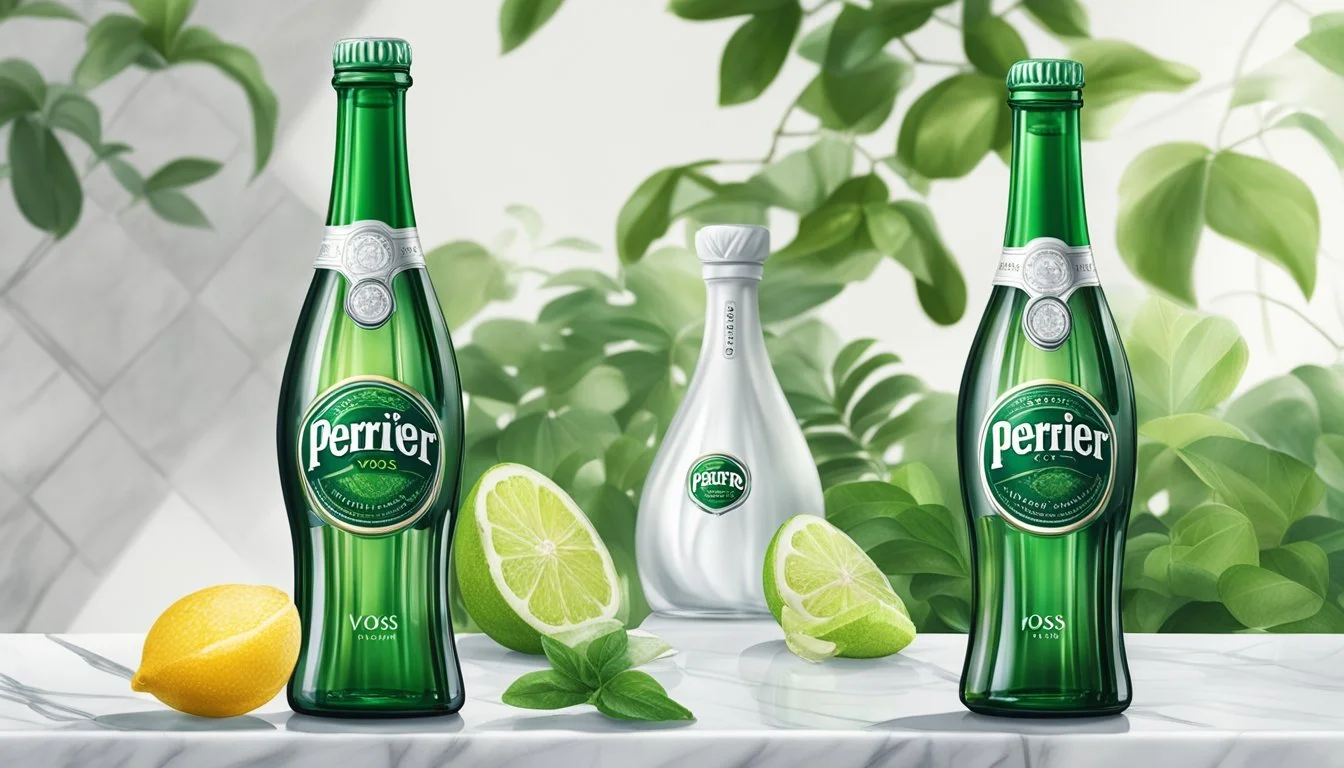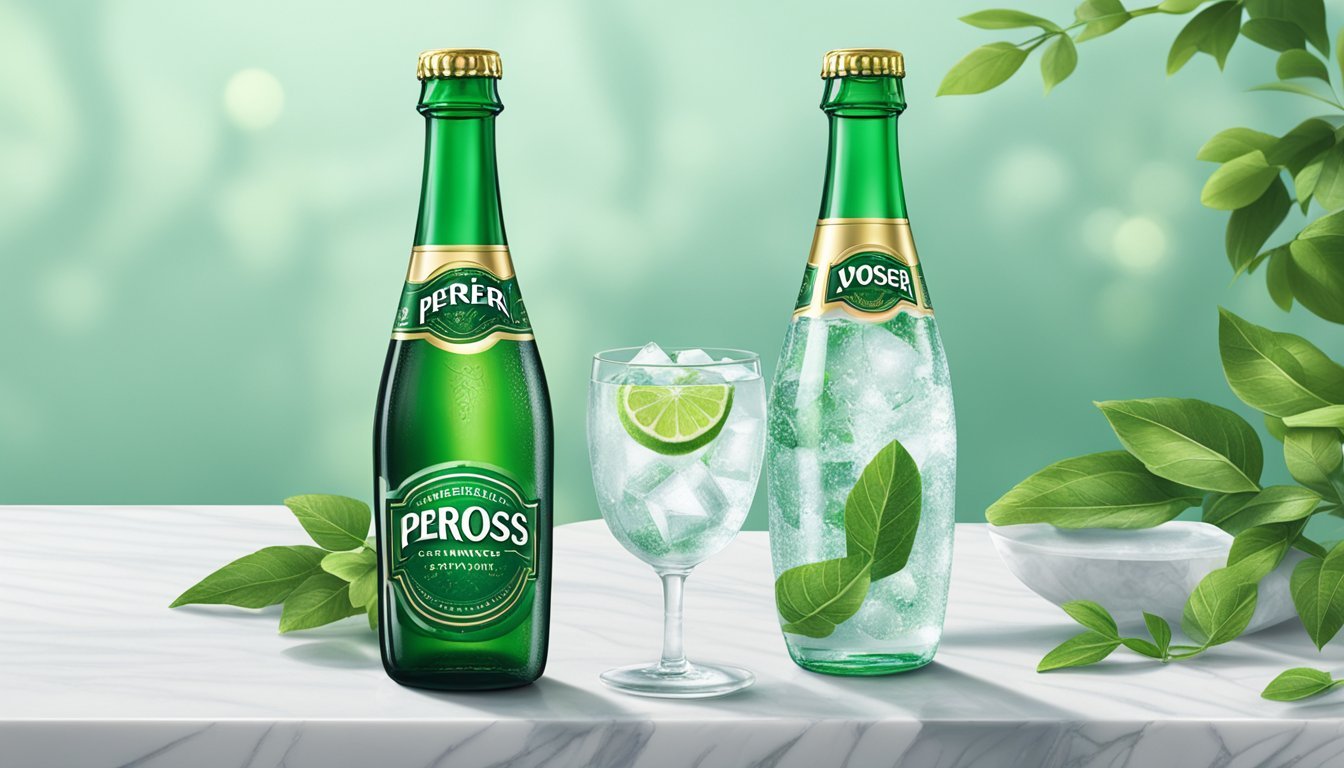Perrier vs. Voss
Unveiling the Superior Bottled Water Choice
In the realm of bottled water, two names often come to prominence: Perrier and Voss. These brands have established themselves as premium choices within an industry that capitalizes on purity, taste, and often sophistication. Perrier, known for its carbonation and distinctive green bottle, boasts a long history and springs from the Vergèze in the South of France. The brand's naturally sparkling water is filtered through limestone formations and gains its effervescence from the addition of naturally occurring gas from the spring.
On the other hand, Voss stakes its reputation on the low Total Dissolved Solids (TDS) levels and the clean, untouched quality of its source. The Norwegian brand sources its artesian water from an aquifer in the wilds of Norway, promising a pure and fresh taste free from additional treatments. While the choices in bottled water may seem overwhelming, the debate between Perrier and Voss is not just about hydration, but also the experience and quality each brand promises to deliver.
Consumers often make their selection based on a variety of factors including taste, source purity, brand ethos, and environmental impact. Perrier and Voss align themselves with distinct markets and preferences, appealing to those who value heritage or the promise of purity. Discerning the subtle differences and determining which bottled water is superior involves a closer look at these elements.
Understanding Bottled Water
Bottled water comes in various forms ranging from purified to naturally mineral-enriched, and its quality is governed by strict regulations. The methods used to ensure the water's purity impact both its taste and sustainability.
Source and Types of Bottled Water
Bottled water brands like Evian and Perrier originate from protected underground sources, such as natural springs or artesian aquifers. Evian is sourced from the French Alps, while Voss comes from Norway's pristine aquifers. Dasani, a product of Coca-Cola, and Aquafina, from PepsiCo, are examples of purified waters, often originating from municipal sources, also known as tap water, and then undergoing various filtration processes.
Bottled Water Regulation and Standards
The quality and safety of bottled water are regulated by various organizations. In the United States, the Environmental Protection Agency (EPA) regulates tap water, while the Food and Drug Administration (FDA) oversees the bottled water industry, ensuring standards for quality and safety are met. These regulations help maintain consumer trust and ensure that bottled water is safe to drink.
Filtration and Purification Processes
Filtration and purification processes are vital in producing clean drinking water. They can include methods like reverse osmosis, ultraviolet light, and ozone treatment. Technologies such as carbon filtration are used to remove contaminants. SmartWater, under the Glacéau brand, is vapor-distilled with added electrolytes. Nestle Pure Life undergoes a 12-step quality process to ensure its safety and quality.
Environmental Impact and Sustainability
The demand for bottled water has significant environmental implications, particularly concerning plastic waste and resource extraction. Bottled water companies are responding by investing in sustainable practices, such as BPA-free packaging and sourcing from areas with abundant water supplies to minimize impacts. The industry's environmental footprint also includes factors like the transportation of products and the extraction of groundwater, which can affect local ecosystems.
Chemical Composition and Health Benefits
In comparing Perrier and Voss bottled waters, it is essential to evaluate their mineral content, acidity, and level of purity, as these factors directly impact their health benefits.
Minerals and Electrolytes in Water
Perrier water is known for its rich mineral content, including calcium, magnesium, potassium, and sodium. These minerals and electrolytes are vital for hydration, muscle function, and overall health. Voss, on the other hand, is an artesian water with a unique mineral composition due to the filtration through volcanic rock.
Table: Mineral Content Comparison Perrier vs. Voss
Mineral Perrier (mg/L) Voss (mg/L) Calcium 147.3 5 Magnesium 3.4 1 Potassium 0.6 0 Sodium 9.5 90
pH Levels and Acidity
The pH level is a scale that measures how acidic or basic a water is on a scale from 0 to 14. Neutral water has a pH of 7. Perrier has a slightly acidic pH, typically less than 6.0, due to its carbonation. Voss boasts a neutral pH, which is closer to the body's natural pH and thus considered beneficial for maintaining a balanced internal environment.
Contaminants and Purity
Purity in bottled water is pivotal for health and safety. Both Perrier and Voss undergo processes to ensure low levels of contaminants. Reverse osmosis and filtration systems are commonly used to reduce total dissolved solids (TDS), heavy metals, and other potential contaminants. Voss claims minimal TDS, which is a result of the protected artesian source, while filtration through volcanic rock adds to the purity of the water by natural means.
Brand Comparison: Perrier vs Voss
When comparing Perrier and Voss, two leading premium bottled water brands, one must consider their source, production processes, product variety, and brand presentation to understand their market positioning and consumer appeal.
Origin and Water Source
Perrier water originates from a spring in the French Alps, known for producing naturally carbonated water embedded with minerals. In contrast, Voss water is sourced from the pristine aquifers of Norway, boasting a low mineral content and purity. Both brands have established a reputation for sourcing their water from unique and naturally replenishing environments.
Production and Bottling Process
Perrier's production process involves capturing the water together with its natural carbonation at the source. In addition, they offer a range of flavors infused with natural extracts without adding sugar or calories. On the flip side, Voss's water undergoes a purification process but retains its natural minerals, offering the option of still or sparkling varieties. Neither brand uses reverse osmosis or vapor-distilled water, focusing instead on the natural purity of their sources.
Product Range and Flavors
Perrier is widely recognized for its sparkling water, which comes in both unflavored and an assortment of fruit-flavored options, including lime and grapefruit. Voss, while known for its still water offering, has expanded into flavored sparkling water, adding selections such as lemon cucumber and tangerine lemongrass to their lineup. Both brands have responded to consumer demand for varied taste profiles in bottled waters.
Packaging and Branding
Perrier is often associated with its iconic green bottle and distinctive brand logo, symbolizing refinement and elegance. Voss, meanwhile, is characterized by its sleek, cylindrical bottle design, often perceived as a symbol of luxury. Although both brands are positioned at a higher price point compared to other bottled water brands like Aquafina or Mountain Valley, they maintain their strong identities and attract consumers looking for premium bottled water experiences.
Comparative Analysis
This section meticulously contrasts Perrier and Voss bottled waters, dissecting key elements from taste to consumer trends, which aids in determining which brand offers the superior product.
Taste and Palate
Perrier, a French brand, is characterized by its natural carbonation and distinctive taste that comes from the combination of minerals and gasses at the source. It is often described as fizzier than its competitors, making it a preferred choice for consumers seeking a sharp and refreshing sensation. Voss, sourced from Norway, is known for its purity and fresh taste with its low Total Dissolved Solids (TDS) levels, which contributes to its clean and crisp flavor profile. Both have engaged in blind taste tests, with varying results that often come down to individual preference for effervescence and minerality in their water.
Nutritional Content Comparison
Perrier positions itself as a mineral-rich water, containing a variety of minerals like calcium, magnesium, and bicarbonate. It has been a go-to option for those seeking the electrolyte enhancement traditionally associated with mineral waters. Voss, on the other hand, offers an alkaline water line called Voss+, which boasts added electrolytes without the mineral taste. For consumers seeking to maintain a balanced intake of electrolytes, both brands cater to their needs, though the mineral content differs.
Mineral Content per Liter:
Perrier: 400-800 mg of bicarbonate, 150 mg of calcium, 4 mg of sodium
Voss: Low TDS, added electrolytes in Voss+ products
Price and Value for Money
In terms of pricing, both Perrier and Voss are deemed premium brands. The price for a bottle of Voss may be slightly higher on average compared to Perrier. Financially conscious shoppers often gravitate towards more cost-effective brands such as Aquafina. However, for those invested in the unique taste and brand prestige, the cost per litre is secondary to the sensory and social experience they seek from Perrier or Voss.
Market Presence and Consumer Preference
Perrier enjoys a historic reputation and is ubiquitously available, often regarded as a staple in the mineral water segment. It has maintained popularity among consumers who prioritize traditional mineral water composition. Voss has a strong presence as well, capturing a market segment that prefers style and a modern brand image, reflected in its sleek bottle design. Both brands face competition from other major players such as San Pellegrino, Mountain Valley, and Essentia, each vying for their share in a market that places high importance on brand perception and customer loyalty.
Consumer Insights
When examining consumer preferences for bottled water, specifically Perrier and Voss, taste, health trends, and brand influence are critical factors.
Taste Tests and Reviews
Consumers often express their preferences through taste tests and online reviews. Perrier, recognized for its carbonation and distinctive green bottle, frequently ranks well for its crisp taste profile. Voss, on the other hand, is lauded for its purity and clean taste, often tied to the brand's image of luxury. Blind taste tests have shown varied results, with some consumers unable to distinguish between premium brands like Voss and more accessible brands like Nestlé Pure Life or Fiji Water.
Health and Wellness Trends
In terms of health, consumers are increasingly aware of the benefits of alkaline water and seek brands that offer these properties. Penta and Eternal Water are two such brands that highlight their alkaline pH levels. Another health consideration is the presence of electrolytes in bottled water, with preferences sometimes swaying towards brands like Gatorade or Life WTR due to their added electrolytes, which cater to athletic individuals looking for hydration and nutrient replenishment. On the other hand, San Pellegrino competes by offering not just hydration but also antioxidants and natural flavors in its sparkling mineral waters.
Marketing and Brand Loyalty
Marketing initiatives play a significant role in shaping consumers' perception and loyalty to water brands. Creative marketing strategies, such as Voss's use of sleek, cylindrical bottles and partnerships with high-end restaurants, have undoubtedly influenced its brand image among consumers. Perrier similarly leverages its heritage and association with artists and creativity to maintain a loyal consumer base. Brand loyalty is less evident in functional beverages like Gatorade, where the focus is more on the product's utility rather than the brand's image.
Conclusion
When comparing Perrier and VOSS bottled water, the decision on which water is "better" centers on individual preferences concerning taste, source, and mineral content.
Perrier is a sparkling mineral water with a distinctively crisp carbonation and trace minerals sourced from the south of France. A unique feature of Perrier is its natural carbonation and heritage, backed by a long-standing history that adds to its prestige.
On the other hand, VOSS boasts an exceptional purity with remarkably low Total Dissolved Solids (TDS), sourced from an aquifer in Norway. It is valued for its clean taste and the natural filtration process it undergoes.
Here are key points to consider:
Perrier:
Sparkling with natural carbonation
Sourced from France
Distinctive taste due to trace minerals
VOSS:
Still water with low TDS
Sourced from Norway
Noted for its pure and clean taste
Neither water is objectively the best bottled water; it largely comes down to whether consumers prefer sparkling or still water, wish to indulge in the unique minerality of Perrier, or prefer the soft, pure essence of VOSS. Both brands represent the upper echelon of bottled waters, each with its dedicated following. Ultimately, the choice between Perrier and VOSS will depend on the consumers' palate and their priorities for water source purity, taste, and the overall drinking experience.






